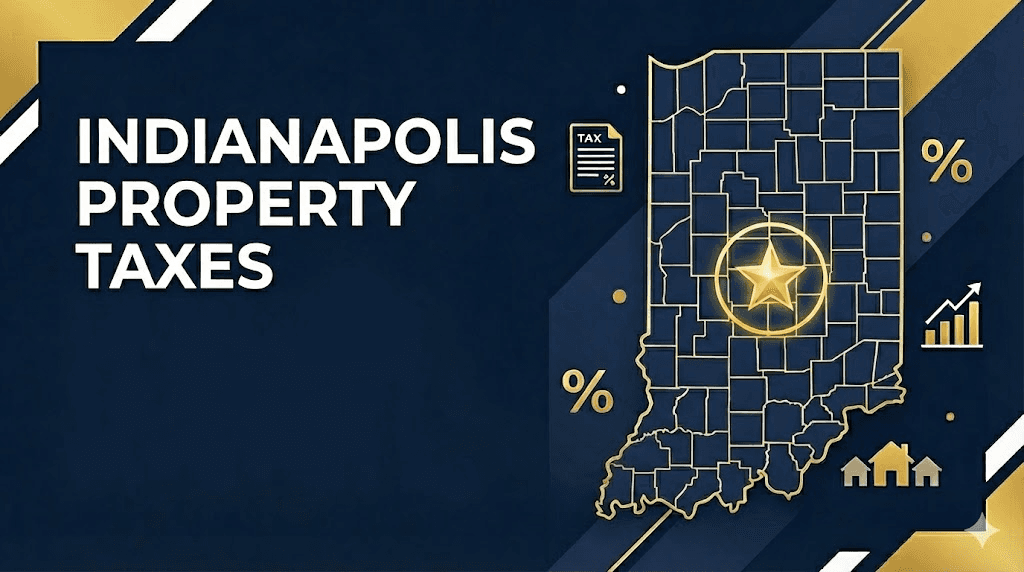Imagine selling a commercial building in Indianapolis and not cutting a check for capital gains taxes — because you rolled the profits into another income-producing property. That’s the power of a 1031 exchange.
For Indiana investors eyeing the 2025 market, this strategy can unlock serious compounding potential. Here’s how a 1031 exchange works in Indiana, what’s changed for 2025, and how to pull one off like a pro.
What Is a 1031 Exchange (and Why Indiana Investors Should Care)
A 1031 exchange lets you defer capital gains taxes when you sell an investment or business property and reinvest the proceeds into another “like-kind” property.
It’s not tax-free — it’s tax-deferred — meaning your profits stay invested and working for you instead of going to the IRS.
Key points to remember:
The property you sell must be held for investment or business use (not a personal residence).
The property you buy must also be investment real estate.
To stay compliant, you must follow strict timelines and work with a Qualified Intermediary (QI) who handles the transaction.
Why 2025 Is the Right Time to Use a 1031 in Indiana
The Indiana market is setting up nicely for long-term investors.
Industrial properties in Indianapolis had a vacancy rate of about 9% in Q3 2025, according to Cushman & Wakefield.
Commercial listings in the metro were seeing median asking prices around $1.1 million and cap rates near 7.2%, according to Crexi (May 2025).
Indiana’s affordability, business-friendly policies, and steady growth make it ideal for reinvesting your deferred gains.
When you combine tax-deferred reinvestment with Indiana’s stability, you’re compounding pre-tax capital into a market that’s still relatively undervalued compared to coastal metros.
Step-by-Step: How to Do a 1031 Exchange in Indiana (2025 Edition)
1. Confirm Eligibility
Make sure your current (relinquished) property qualifies — it needs to be used for investment or business. Personal residences don’t count.
2. Hire a Qualified Intermediary (Before Closing)
A QI holds your sale proceeds during the exchange. If the funds touch your account, the exchange is invalid — game over.
3. Follow the Two Deadlines
45 Days: Identify your replacement property (or properties).
180 Days: Close on the replacement property.
Miss either, and you lose tax-deferral status.
4. Match or Increase Value and Debt
To fully defer taxes:
Reinvest all your cash proceeds.
Replace the same or greater debt.
Any leftover cash (“boot”) gets taxed.
5. Pick the Right Replacement Property
Use one of two IRS-approved identification rules:
Three-Property Rule: Identify up to three properties, any value.
200% Rule: Identify more than three, as long as total value ≤ 200% of what you sold.
6. Close and Report
Close within 180 days, use your QI to move funds, and report the exchange on IRS Form 8824 when filing taxes.
7. Hold the Replacement Property
Hold your new property for at least 2 years to show investment intent — flipping too fast can trigger IRS scrutiny.
Indiana Market Strategy for 2025 Investors
Smart Indiana investors are using 1031 exchanges to reposition into assets with stronger long-term returns. A few examples:
Industrial & Logistics Assets: The I-65 and I-70 corridors continue to attract investors as e-commerce distribution demand stays strong.
Adaptive Reuse Projects: Older suburban offices and retail spaces are being repurposed for mixed-use and multifamily.
Multifamily Trade-Ups: Swapping out of older duplexes into newer, stabilized multifamily or self-storage facilities.
Farmland to Income Property: Some owners are exchanging agricultural land for cash-flowing commercial real estate in central Indiana.
If you’re considering a 1031 this year, check out our companion post on Real Estate Investor Tax Strategies 2025: Indiana for additional year-end tax planning moves.
Key Risks and Mistakes to Avoid
Even seasoned investors can get tripped up by small details. Avoid these pitfalls:
Missing the 45/180-Day Windows: There are no extensions.
Taking Cash or Non-Like-Kind Property: Any “boot” becomes taxable.
Poor Documentation: Failing to note 1031 intent in your sale contract.
Changing Use Too Soon: Turning your new investment into a personal property too quickly can disqualify the exchange.
Interest Rate Sensitivity: Financing costs in 2025 are hovering near 6–6.5%, so factor that into your ROI calculations.
2025 Data Check: Why Indy’s Market Supports Exchanges
A few local data points give context:
Industrial vacancy: ~9.0% (Cushman & Wakefield, Q3 2025)
Retail cap rates: ~7.2% (Crexi, May 2025)
Projected wage growth: 3.9% in the Indy metro (Indiana Business Research Center, 2025 Outlook)
These fundamentals create a stable backdrop for exchanging into long-term rental or commercial assets.
Quick FAQs for Indiana Investors
What’s the average cap rate for commercial properties in Indianapolis right now?
Around 7.2% as of mid-2025 — higher than many peer metros, offering strong yield potential.
Can I exchange a commercial building for a residential rental?
Yes, as long as the rental property is for investment use and not your personal home.
Does Indiana tax 1031 exchanges differently?
No. Indiana conforms to federal rules for real property exchanges. Just ensure your CPA understands state filing nuances.
How long should I hold the replacement property?
Generally 2–5 years. Selling too soon risks invalidating the exchange.
Can farmland qualify?
Yes. Many Indiana investors exchange farmland for commercial or multifamily properties.
Wrapping It Up
A 1031 exchange isn’t just a tax move — it’s a long-term compounding strategy. By deferring taxes and reinvesting those dollars into stronger assets, you’re effectively building wealth with pre-tax money.
If you’re holding appreciated property in Indiana and considering your next move, this might be your moment to trade up strategically.
Want a deeper dive into property strategy before pulling the trigger? Check out Fix-and-Flip vs Buy-and-Hold: Indianapolis for insights on different investment approaches.
Ready to start your 1031 game plan? Reach out to Roots Realty Co. — we help Indiana investors identify replacement properties, connect with trusted QIs, and structure deals that keep your portfolio growing.
Investor Resources: https://rootsrealty.co/invest/investor-resources
Join our newsletter: https://rootsrealty.co/join-roots-newsletter
Imagine selling a commercial building in Indianapolis and not cutting a check for capital gains taxes — because you rolled the profits into another income-producing property. That’s the power of a 1031 exchange.
For Indiana investors eyeing the 2025 market, this strategy can unlock serious compounding potential. Here’s how a 1031 exchange works in Indiana, what’s changed for 2025, and how to pull one off like a pro.
What Is a 1031 Exchange (and Why Indiana Investors Should Care)
A 1031 exchange lets you defer capital gains taxes when you sell an investment or business property and reinvest the proceeds into another “like-kind” property.
It’s not tax-free — it’s tax-deferred — meaning your profits stay invested and working for you instead of going to the IRS.
Key points to remember:
The property you sell must be held for investment or business use (not a personal residence).
The property you buy must also be investment real estate.
To stay compliant, you must follow strict timelines and work with a Qualified Intermediary (QI) who handles the transaction.
Why 2025 Is the Right Time to Use a 1031 in Indiana
The Indiana market is setting up nicely for long-term investors.
Industrial properties in Indianapolis had a vacancy rate of about 9% in Q3 2025, according to Cushman & Wakefield.
Commercial listings in the metro were seeing median asking prices around $1.1 million and cap rates near 7.2%, according to Crexi (May 2025).
Indiana’s affordability, business-friendly policies, and steady growth make it ideal for reinvesting your deferred gains.
When you combine tax-deferred reinvestment with Indiana’s stability, you’re compounding pre-tax capital into a market that’s still relatively undervalued compared to coastal metros.
Step-by-Step: How to Do a 1031 Exchange in Indiana (2025 Edition)
1. Confirm Eligibility
Make sure your current (relinquished) property qualifies — it needs to be used for investment or business. Personal residences don’t count.
2. Hire a Qualified Intermediary (Before Closing)
A QI holds your sale proceeds during the exchange. If the funds touch your account, the exchange is invalid — game over.
3. Follow the Two Deadlines
45 Days: Identify your replacement property (or properties).
180 Days: Close on the replacement property.
Miss either, and you lose tax-deferral status.
4. Match or Increase Value and Debt
To fully defer taxes:
Reinvest all your cash proceeds.
Replace the same or greater debt.
Any leftover cash (“boot”) gets taxed.
5. Pick the Right Replacement Property
Use one of two IRS-approved identification rules:
Three-Property Rule: Identify up to three properties, any value.
200% Rule: Identify more than three, as long as total value ≤ 200% of what you sold.
6. Close and Report
Close within 180 days, use your QI to move funds, and report the exchange on IRS Form 8824 when filing taxes.
7. Hold the Replacement Property
Hold your new property for at least 2 years to show investment intent — flipping too fast can trigger IRS scrutiny.
Indiana Market Strategy for 2025 Investors
Smart Indiana investors are using 1031 exchanges to reposition into assets with stronger long-term returns. A few examples:
Industrial & Logistics Assets: The I-65 and I-70 corridors continue to attract investors as e-commerce distribution demand stays strong.
Adaptive Reuse Projects: Older suburban offices and retail spaces are being repurposed for mixed-use and multifamily.
Multifamily Trade-Ups: Swapping out of older duplexes into newer, stabilized multifamily or self-storage facilities.
Farmland to Income Property: Some owners are exchanging agricultural land for cash-flowing commercial real estate in central Indiana.
If you’re considering a 1031 this year, check out our companion post on Real Estate Investor Tax Strategies 2025: Indiana for additional year-end tax planning moves.
Key Risks and Mistakes to Avoid
Even seasoned investors can get tripped up by small details. Avoid these pitfalls:
Missing the 45/180-Day Windows: There are no extensions.
Taking Cash or Non-Like-Kind Property: Any “boot” becomes taxable.
Poor Documentation: Failing to note 1031 intent in your sale contract.
Changing Use Too Soon: Turning your new investment into a personal property too quickly can disqualify the exchange.
Interest Rate Sensitivity: Financing costs in 2025 are hovering near 6–6.5%, so factor that into your ROI calculations.
2025 Data Check: Why Indy’s Market Supports Exchanges
A few local data points give context:
Industrial vacancy: ~9.0% (Cushman & Wakefield, Q3 2025)
Retail cap rates: ~7.2% (Crexi, May 2025)
Projected wage growth: 3.9% in the Indy metro (Indiana Business Research Center, 2025 Outlook)
These fundamentals create a stable backdrop for exchanging into long-term rental or commercial assets.
Quick FAQs for Indiana Investors
What’s the average cap rate for commercial properties in Indianapolis right now?
Around 7.2% as of mid-2025 — higher than many peer metros, offering strong yield potential.
Can I exchange a commercial building for a residential rental?
Yes, as long as the rental property is for investment use and not your personal home.
Does Indiana tax 1031 exchanges differently?
No. Indiana conforms to federal rules for real property exchanges. Just ensure your CPA understands state filing nuances.
How long should I hold the replacement property?
Generally 2–5 years. Selling too soon risks invalidating the exchange.
Can farmland qualify?
Yes. Many Indiana investors exchange farmland for commercial or multifamily properties.
Wrapping It Up
A 1031 exchange isn’t just a tax move — it’s a long-term compounding strategy. By deferring taxes and reinvesting those dollars into stronger assets, you’re effectively building wealth with pre-tax money.
If you’re holding appreciated property in Indiana and considering your next move, this might be your moment to trade up strategically.
Want a deeper dive into property strategy before pulling the trigger? Check out Fix-and-Flip vs Buy-and-Hold: Indianapolis for insights on different investment approaches.
Ready to start your 1031 game plan? Reach out to Roots Realty Co. — we help Indiana investors identify replacement properties, connect with trusted QIs, and structure deals that keep your portfolio growing.
Investor Resources: https://rootsrealty.co/invest/investor-resources
Join our newsletter: https://rootsrealty.co/join-roots-newsletter
Imagine selling a commercial building in Indianapolis and not cutting a check for capital gains taxes — because you rolled the profits into another income-producing property. That’s the power of a 1031 exchange.
For Indiana investors eyeing the 2025 market, this strategy can unlock serious compounding potential. Here’s how a 1031 exchange works in Indiana, what’s changed for 2025, and how to pull one off like a pro.
What Is a 1031 Exchange (and Why Indiana Investors Should Care)
A 1031 exchange lets you defer capital gains taxes when you sell an investment or business property and reinvest the proceeds into another “like-kind” property.
It’s not tax-free — it’s tax-deferred — meaning your profits stay invested and working for you instead of going to the IRS.
Key points to remember:
The property you sell must be held for investment or business use (not a personal residence).
The property you buy must also be investment real estate.
To stay compliant, you must follow strict timelines and work with a Qualified Intermediary (QI) who handles the transaction.
Why 2025 Is the Right Time to Use a 1031 in Indiana
The Indiana market is setting up nicely for long-term investors.
Industrial properties in Indianapolis had a vacancy rate of about 9% in Q3 2025, according to Cushman & Wakefield.
Commercial listings in the metro were seeing median asking prices around $1.1 million and cap rates near 7.2%, according to Crexi (May 2025).
Indiana’s affordability, business-friendly policies, and steady growth make it ideal for reinvesting your deferred gains.
When you combine tax-deferred reinvestment with Indiana’s stability, you’re compounding pre-tax capital into a market that’s still relatively undervalued compared to coastal metros.
Step-by-Step: How to Do a 1031 Exchange in Indiana (2025 Edition)
1. Confirm Eligibility
Make sure your current (relinquished) property qualifies — it needs to be used for investment or business. Personal residences don’t count.
2. Hire a Qualified Intermediary (Before Closing)
A QI holds your sale proceeds during the exchange. If the funds touch your account, the exchange is invalid — game over.
3. Follow the Two Deadlines
45 Days: Identify your replacement property (or properties).
180 Days: Close on the replacement property.
Miss either, and you lose tax-deferral status.
4. Match or Increase Value and Debt
To fully defer taxes:
Reinvest all your cash proceeds.
Replace the same or greater debt.
Any leftover cash (“boot”) gets taxed.
5. Pick the Right Replacement Property
Use one of two IRS-approved identification rules:
Three-Property Rule: Identify up to three properties, any value.
200% Rule: Identify more than three, as long as total value ≤ 200% of what you sold.
6. Close and Report
Close within 180 days, use your QI to move funds, and report the exchange on IRS Form 8824 when filing taxes.
7. Hold the Replacement Property
Hold your new property for at least 2 years to show investment intent — flipping too fast can trigger IRS scrutiny.
Indiana Market Strategy for 2025 Investors
Smart Indiana investors are using 1031 exchanges to reposition into assets with stronger long-term returns. A few examples:
Industrial & Logistics Assets: The I-65 and I-70 corridors continue to attract investors as e-commerce distribution demand stays strong.
Adaptive Reuse Projects: Older suburban offices and retail spaces are being repurposed for mixed-use and multifamily.
Multifamily Trade-Ups: Swapping out of older duplexes into newer, stabilized multifamily or self-storage facilities.
Farmland to Income Property: Some owners are exchanging agricultural land for cash-flowing commercial real estate in central Indiana.
If you’re considering a 1031 this year, check out our companion post on Real Estate Investor Tax Strategies 2025: Indiana for additional year-end tax planning moves.
Key Risks and Mistakes to Avoid
Even seasoned investors can get tripped up by small details. Avoid these pitfalls:
Missing the 45/180-Day Windows: There are no extensions.
Taking Cash or Non-Like-Kind Property: Any “boot” becomes taxable.
Poor Documentation: Failing to note 1031 intent in your sale contract.
Changing Use Too Soon: Turning your new investment into a personal property too quickly can disqualify the exchange.
Interest Rate Sensitivity: Financing costs in 2025 are hovering near 6–6.5%, so factor that into your ROI calculations.
2025 Data Check: Why Indy’s Market Supports Exchanges
A few local data points give context:
Industrial vacancy: ~9.0% (Cushman & Wakefield, Q3 2025)
Retail cap rates: ~7.2% (Crexi, May 2025)
Projected wage growth: 3.9% in the Indy metro (Indiana Business Research Center, 2025 Outlook)
These fundamentals create a stable backdrop for exchanging into long-term rental or commercial assets.
Quick FAQs for Indiana Investors
What’s the average cap rate for commercial properties in Indianapolis right now?
Around 7.2% as of mid-2025 — higher than many peer metros, offering strong yield potential.
Can I exchange a commercial building for a residential rental?
Yes, as long as the rental property is for investment use and not your personal home.
Does Indiana tax 1031 exchanges differently?
No. Indiana conforms to federal rules for real property exchanges. Just ensure your CPA understands state filing nuances.
How long should I hold the replacement property?
Generally 2–5 years. Selling too soon risks invalidating the exchange.
Can farmland qualify?
Yes. Many Indiana investors exchange farmland for commercial or multifamily properties.
Wrapping It Up
A 1031 exchange isn’t just a tax move — it’s a long-term compounding strategy. By deferring taxes and reinvesting those dollars into stronger assets, you’re effectively building wealth with pre-tax money.
If you’re holding appreciated property in Indiana and considering your next move, this might be your moment to trade up strategically.
Want a deeper dive into property strategy before pulling the trigger? Check out Fix-and-Flip vs Buy-and-Hold: Indianapolis for insights on different investment approaches.
Ready to start your 1031 game plan? Reach out to Roots Realty Co. — we help Indiana investors identify replacement properties, connect with trusted QIs, and structure deals that keep your portfolio growing.
Investor Resources: https://rootsrealty.co/invest/investor-resources
Join our newsletter: https://rootsrealty.co/join-roots-newsletter
Imagine selling a commercial building in Indianapolis and not cutting a check for capital gains taxes — because you rolled the profits into another income-producing property. That’s the power of a 1031 exchange.
For Indiana investors eyeing the 2025 market, this strategy can unlock serious compounding potential. Here’s how a 1031 exchange works in Indiana, what’s changed for 2025, and how to pull one off like a pro.
What Is a 1031 Exchange (and Why Indiana Investors Should Care)
A 1031 exchange lets you defer capital gains taxes when you sell an investment or business property and reinvest the proceeds into another “like-kind” property.
It’s not tax-free — it’s tax-deferred — meaning your profits stay invested and working for you instead of going to the IRS.
Key points to remember:
The property you sell must be held for investment or business use (not a personal residence).
The property you buy must also be investment real estate.
To stay compliant, you must follow strict timelines and work with a Qualified Intermediary (QI) who handles the transaction.
Why 2025 Is the Right Time to Use a 1031 in Indiana
The Indiana market is setting up nicely for long-term investors.
Industrial properties in Indianapolis had a vacancy rate of about 9% in Q3 2025, according to Cushman & Wakefield.
Commercial listings in the metro were seeing median asking prices around $1.1 million and cap rates near 7.2%, according to Crexi (May 2025).
Indiana’s affordability, business-friendly policies, and steady growth make it ideal for reinvesting your deferred gains.
When you combine tax-deferred reinvestment with Indiana’s stability, you’re compounding pre-tax capital into a market that’s still relatively undervalued compared to coastal metros.
Step-by-Step: How to Do a 1031 Exchange in Indiana (2025 Edition)
1. Confirm Eligibility
Make sure your current (relinquished) property qualifies — it needs to be used for investment or business. Personal residences don’t count.
2. Hire a Qualified Intermediary (Before Closing)
A QI holds your sale proceeds during the exchange. If the funds touch your account, the exchange is invalid — game over.
3. Follow the Two Deadlines
45 Days: Identify your replacement property (or properties).
180 Days: Close on the replacement property.
Miss either, and you lose tax-deferral status.
4. Match or Increase Value and Debt
To fully defer taxes:
Reinvest all your cash proceeds.
Replace the same or greater debt.
Any leftover cash (“boot”) gets taxed.
5. Pick the Right Replacement Property
Use one of two IRS-approved identification rules:
Three-Property Rule: Identify up to three properties, any value.
200% Rule: Identify more than three, as long as total value ≤ 200% of what you sold.
6. Close and Report
Close within 180 days, use your QI to move funds, and report the exchange on IRS Form 8824 when filing taxes.
7. Hold the Replacement Property
Hold your new property for at least 2 years to show investment intent — flipping too fast can trigger IRS scrutiny.
Indiana Market Strategy for 2025 Investors
Smart Indiana investors are using 1031 exchanges to reposition into assets with stronger long-term returns. A few examples:
Industrial & Logistics Assets: The I-65 and I-70 corridors continue to attract investors as e-commerce distribution demand stays strong.
Adaptive Reuse Projects: Older suburban offices and retail spaces are being repurposed for mixed-use and multifamily.
Multifamily Trade-Ups: Swapping out of older duplexes into newer, stabilized multifamily or self-storage facilities.
Farmland to Income Property: Some owners are exchanging agricultural land for cash-flowing commercial real estate in central Indiana.
If you’re considering a 1031 this year, check out our companion post on Real Estate Investor Tax Strategies 2025: Indiana for additional year-end tax planning moves.
Key Risks and Mistakes to Avoid
Even seasoned investors can get tripped up by small details. Avoid these pitfalls:
Missing the 45/180-Day Windows: There are no extensions.
Taking Cash or Non-Like-Kind Property: Any “boot” becomes taxable.
Poor Documentation: Failing to note 1031 intent in your sale contract.
Changing Use Too Soon: Turning your new investment into a personal property too quickly can disqualify the exchange.
Interest Rate Sensitivity: Financing costs in 2025 are hovering near 6–6.5%, so factor that into your ROI calculations.
2025 Data Check: Why Indy’s Market Supports Exchanges
A few local data points give context:
Industrial vacancy: ~9.0% (Cushman & Wakefield, Q3 2025)
Retail cap rates: ~7.2% (Crexi, May 2025)
Projected wage growth: 3.9% in the Indy metro (Indiana Business Research Center, 2025 Outlook)
These fundamentals create a stable backdrop for exchanging into long-term rental or commercial assets.
Quick FAQs for Indiana Investors
What’s the average cap rate for commercial properties in Indianapolis right now?
Around 7.2% as of mid-2025 — higher than many peer metros, offering strong yield potential.
Can I exchange a commercial building for a residential rental?
Yes, as long as the rental property is for investment use and not your personal home.
Does Indiana tax 1031 exchanges differently?
No. Indiana conforms to federal rules for real property exchanges. Just ensure your CPA understands state filing nuances.
How long should I hold the replacement property?
Generally 2–5 years. Selling too soon risks invalidating the exchange.
Can farmland qualify?
Yes. Many Indiana investors exchange farmland for commercial or multifamily properties.
Wrapping It Up
A 1031 exchange isn’t just a tax move — it’s a long-term compounding strategy. By deferring taxes and reinvesting those dollars into stronger assets, you’re effectively building wealth with pre-tax money.
If you’re holding appreciated property in Indiana and considering your next move, this might be your moment to trade up strategically.
Want a deeper dive into property strategy before pulling the trigger? Check out Fix-and-Flip vs Buy-and-Hold: Indianapolis for insights on different investment approaches.
Ready to start your 1031 game plan? Reach out to Roots Realty Co. — we help Indiana investors identify replacement properties, connect with trusted QIs, and structure deals that keep your portfolio growing.
Investor Resources: https://rootsrealty.co/invest/investor-resources
Join our newsletter: https://rootsrealty.co/join-roots-newsletter








